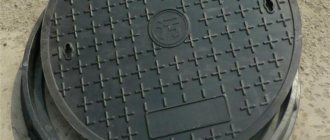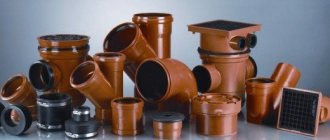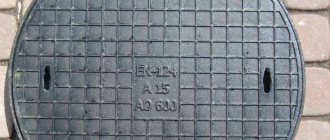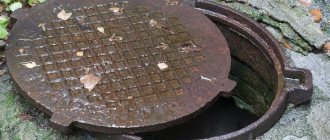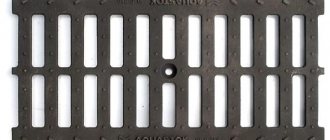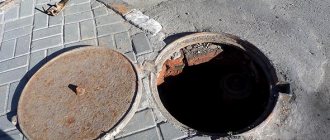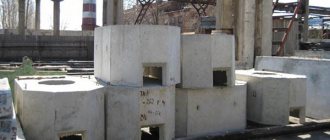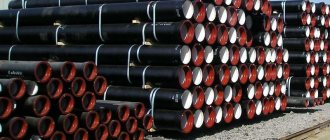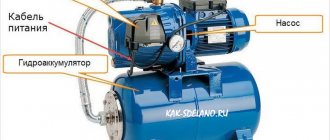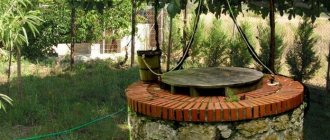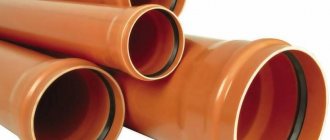What does a cast iron hatch look like?
Cast iron hatch
Construction of wells for installation of cast iron hatches
The design of the sewer well includes:
- Space for installation, repair and inspection of pipeline condition
- A shaft for lowering workers to technical corridors.
- Cast iron water hatch that closes and opens access to the shaft.
The height of technical corridors depends on the purpose of the communications used and their type and is usually 1.8 meters. The dimensions of the premises are calculated according to certain standards for various pipeline systems, depth marks are determined by the location of the structure.
well construction
The shaft leading to the technical rooms begins on the surface, it is equipped with a ladder, has a round shape and is made of concrete materials or brickwork.
The cast-iron hatch prevents accidental injury to passers-by and the fall of vehicle wheels, and also protects technical corridors from the penetration of debris from the surface. In most cases, it has a convex round shape, and prevents wastewater from accumulating on its surface and freezing. The cover is made of high-strength cast iron and withstands vibration and impacts from vehicles, does not tip over and is firmly held in the grooves of the structure.
Cast iron drainage hatch, 4 lugs, is used in storm sewers and includes two covers: at the top there is a heavy one to protect the system, underneath there is a lighter one with locking mechanisms, preventing access to the sewer system for unauthorized persons and theft of property. Covers are used in various types of communications - gas pipelines, water pipelines, heating mains, etc.
Cast iron hatches with locking device
cast iron hatch with locking device
Locking mechanisms are often used in hatch designs, which prevent cases of theft of cast iron covers and isolate access to communications and sewerage systems for unauthorized people, as well as securely fasten the structure and prevent cases of loosening and opening of the hatch under the influence of pressure and vibration exerted by the flow of motor vehicles and destroying the base well.
There are several types of locking mechanisms for hatches produced by the manufacturer:
- A lock with a secret having a flag connection of the components of the structure.
- A lock connecting the cover and the base with a threaded bolt.
- A mechanism that locks the lid using several steel pins, blocking access to the well when the lid is closed.
- A lock with spacers that are secured in the holes when aligned with them when closing the well.
Cast iron hatches
Manholes are covers for a manhole in a sewer system. They reliably cover the opening and prevent people and vehicles from getting into it.
The edges of the hatches are inserted into the grooves of the metal base, avoiding protrusions that impede free movement. The joints are securely fastened to prevent loosening when bumping into them. A small gap is left between the hatch and the fastenings, which helps with its lifting and provides access for gas sensors in some types of sewers.
The height of the convexity in the upper part of the hatch does not exceed 2-6 mm from the ground level, its weight is not less than 50 kilograms, and can withstand loads and vibrations.
Depending on the material of manufacture, they are divided into:
- Rubber
- Plastic
- Reinforced concrete and polymer hatches for repair work
polymer reinforced concrete hatch
- Cast iron hatches with the possibility of concreting their base.
Due to the theft of hatches and their delivery to scrap metal points, in some CIS countries, concrete slabs are used as covers. They impede the movement of vehicles, are not durable for dynamic loads, and also create emergency situations; such shortcomings make their use impossible.
GOST
The technology for manufacturing hatches during their production is subject to the requirements described in the following GOSTs:
- For telephone communications: GOST 8591-76.
- For storm drains: GOST 26008-83 and DB-1.
- For sewer systems: EN 124—1994, GOST 3634-99, DSTU B V.2.5-26:2005.
The main advantages of cast iron hatches
- Highly durable for dynamic loads and vibration. Withstands weight up to 90 tons.
- Made of heavy metal, they are stable in the structure and do not open when traffic moves.
- Economical price.
- Withstands various temperature changes.
- The strength of the structure is ensured by the ribbed structure in the surface of the hatch.
- Resistant to external sources of damage.
- Duration of operation.
Multifunctional, depending on size and material:
- Lightweight polymer hatches are used in parks, drainage areas, summer cottages and pedestrian paths.
- Heavy hatches are used in areas with heavy traffic, high vibration and increased loads, as well as for communication networks and pipelines.
Types and installation locations
By application they are divided into:
- Sewer. They are used in the construction of drains for the discharge of technical and contaminated sources.
- Tap water. For water supply systems through pipelines.
- Hatches for heating mains. In heat supply pipelines for boiler and heating systems.
- Communication hatches for telephone cables and fiber-optic communications.
- Protective hatches for gas pipeline stations
- Drainage hatches for storm and waste urban systems.
- Hatches for water supply systems for the needs of fire services.
Depending on the location, they are used:
- Hatches made of heavy cast iron, weighing 55-90 kg, designed for roads and highways with high vehicle traffic.
- Hatches made of light cast iron, used in parks and pedestrian areas, with little vibration and load on them. Their weight is 90-110 kilograms.
- Hatches with average parameters, superior to lightweight ones and inferior to hatches made of heavy cast iron, are used at road junctions with high vibration and vehicle load. They are resistant to loads of up to 50 tons, and their weight is more than 140 kg.
GOST and marking
Technical characteristics and requirements for sewer manholes are regulated by GOST 3634-99. This standard applies to covers of wells and chambers of underground networks of storm and city sewerage, water supply, heat supply, communications and gas pipelines.
The properties of telephone sewer manholes are regulated by GOST 8591-76.
Hatches made from modern polymer materials that do not meet GOST requirements are manufactured according to the customer’s technical specifications or according to the technical conditions developed by the manufacturer.
According to interstate standards, hatches are marked with alphanumeric abbreviations and are divided into the following types:
- ST (E600) - Extra heavy, designed for loads up to 61 tons. The hatch weighs more than 155 kg. Designed for installation in unloading terminals, airfields, and on expressways.
- TM (D 400) - Heavy highway. Designed for installation on high-speed roads. Easily tolerate local loads of up to 40 tons. They weigh up to 140 kg.
- T (250) - Heavy hatches are installed on urban roads with heavy vehicle traffic. The dead weight of heavy hatches can reach 120 kilograms. Designed for loads up to 25 tons.
- C (B125) Medium sewer structures, for installation in city yards, on sidewalks and lawns. Designed for loads of up to 12.5 tons. The weight of the structure is up to 95 kg.
- L (A15) Lightweight hatches that can withstand loads of up to 1.5 tons are installed in pedestrian areas where there is no traffic. They weigh 45-60 kg.
To simplify the procedure for selecting sewer manholes, manufacturers use special markings in accordance with the purpose of utilities:
- K - domestic and industrial sewerage;
- D - rain and storm drainage;
- GW - city water supply networks;
- B - water conduit;
- TS - heating networks;
- PG—fire hydrants;
- MG—trunk gas supply networks;
- GTS - city telephone networks.
According to State standards, sewer manholes must be equipped with special inscriptions and trademarks or logos of the manufacturer.
Fig.6. Storm drain hatch.
Types of cast iron hatches
Heavy cast iron hatches (T)
Heavy cast iron hatch
Sewer hatches made of heavy cast iron protect manholes from flooding by precipitation, prevent collisions with cars and reduce the risk of pedestrians falling into open sewer areas. They are installed on sections of the highway with a large flow of traffic and at road junctions.
The release of finished products from the manufacturer's plant is strictly regulated by the requirements of GOST 3634-99, according to which the hatch design consists of:
- A concrete ring that serves as the walls of the well.
- A cover covering the sewer opening.
- A metal rim into the holes of which the grooves of the cover are inserted.
A rubber gasket softens the impacts of the hatch on its base.
For the manufacture of the hatch, durable grades of cast iron with a tensile strength of 20 kg/mm2 are used, the composition of the material is determined according to GOST 1412-86. The internal valve parts are made from carbon steel ST3, protected with anti-corrosion substances according to GOST 380-2005.
The designation “T” in the product range and additional information about the characteristics of hatches are regulated by GOST 3634-99 and EN 124-1994 - C250. Using them, you can find out what maximum strength a hatch has when loaded on it; with a weight of 120 kg, a pressure of no more than 25 tons/kN is allowed.
Some sets of ready-made hatches do not include rubber gaskets or there is no clearance for them in the structural elements. It is very important to pay attention to this, because... under high loads and vehicle collisions with the manhole cover, it becomes loose and destroys the concrete base. A gasket installed between the hatch and the base softens shock and vibration between them and increases their performance for many years.
Certain types of wells are equipped with locking mechanisms that prevent their opening, the entry of bystanders into the sewer system, or the theft of caps for scrap metal.
Due to its large weight, the hatch cover can withstand the loads and vibrations of large traffic flows and does not fly out of the structure due to impacts from vehicle wheels. The durable composition of the material protects structural elements from destruction and extends their service life, as well as adheres to the road surface and reduces cracks in the asphalt.
Light cast iron hatches (L)
lightweight cast iron hatch
In park areas, pedestrian sidewalks, sewerage, water supply and other communications with a pressure of no more than 1.5-3 tN, in the absence of heavy traffic and heavy loads of freight and passenger transport, hatches made of light alloys, cast iron or plastic materials are used.
The ribbed surface of the hatch reduces its sliding properties and makes it safe to use. The finished covers have a rectangular or round shape, depending on the purpose and location of their installation; the cast iron material of the hatch is impact-resistant and prevents the influence of external factors on the inspection well.
Such hatches are used to clog inspection wells on pipeline sections with debris, ensure safe movement of vehicles, and prevent pedestrians from falling. Gaskets and locks are installed on hatch covers to prevent theft of property.
Trunk (TMR)
floating main hatch
TMR type hatches are designed for areas with very high dynamic loads from 25 to 40 tf and heavy traffic of heavy vehicles. Such places include:
- Motorways and autobahns with many interchanges and multi-level roads.
- Warehouse buildings in industrial areas.
- Ship repair hangars and mooring areas.
They protect inspection wells on pipeline sections from clogging the entire system with debris and prevent vehicle accidents and injuries to pedestrians. Additionally, built-in locking mechanisms protect against unauthorized access of unauthorized persons to the pipeline and its theft.
The production of main hatches is controlled and strictly regulated by GOST 3634–99.
According to this document, the following requirements are imposed on finished products:
- The mass of the hatch for main loads must be at least 140 kg.
- When choosing a material, take into account its resistance to high vibration and the reliability of fastening the hatch when cars collide with its base and the influence of other mechanical damage.
- It is mandatory to have a rubber gasket between the cover and the metal base, which dampens the mechanical impact on the hatch from heavy vehicles and maintains its strength.
- Hatches are made of high-strength grades of gray cast iron with the necessary chemical components specified in GOST.
Telephone
telephone hatch
These hatches are designed for communications and telephone wires, installed on trays with cable branches; the material, strength and chemical composition of the manufactured covers directly depends on the location of their installation and the intensity of pedestrian and vehicle traffic.
Manufactured from light and heavy cast iron, depending on terrain conditions, traffic intensity, load, traffic flow
Floating
floating hatch
The floating hatch is used on highways with a large flow of traffic, industrial areas and other places with a high level of traffic. The peculiarity of the design is the additional strengthening of its edges with concrete walls, on which the entire structure rests and takes on the entire load of transport, maintaining the strength, integrity and durability of the roadway.
Such a hatch has great strength and can withstand loads of up to 40 tons, and due to its stability and anti-corrosion protection, it is widely used in various types of communications, such as gas pipelines, fire service pipelines, underground cables and other systems.
Well hatches
well hatch
Hatches are designed for shafts of water supply systems.
Depending on the installation location, they are made of light or heavy cast iron:
- lightweight ones are used in areas without heavy loads, in park areas and sidewalks, as well as in forest areas and agricultural areas.
- heavy ones are mounted on highways and places with increased traffic intensity and structural load, large road junctions, ports and marinas.
Cast iron hatches are distinguished by their appearance:
- For general purposes.
- Having recesses in the structure for concrete pouring.
- With shutter mechanisms.
- With lid automatically lifted by winch.
- Having a square or rectangular shape.
The technical information from the manufacturer and the markings of the hatch itself describe all the strength characteristics and dimensions, as well as the type of its purpose:
- Sewer.
- Hatches of heating mains.
- Communication
- Tap water.
- Drainage hatches for storm and waste urban systems. Etc.
Cast iron hatch with shell
cast iron hatch with shell
To monitor the condition of the pipeline and underground communications, as well as timely repair and update of systems, shafts are installed in the selected area to provide access and descent of a team of workers to the technical premises. In the manufacture of covers, cast iron of various grades is used depending on the purpose; they are painted black and equipped with locking mechanisms to prevent unauthorized persons from entering the sewer system and stealing equipment.
The surface of the cover has a ribbed shape, providing anti-slip and traction for vehicles on the roadway. The structures are used in various sections of pipelines with high or low load and traffic intensity.
The type of hatch and its purpose are indicated in the product labeling, as are its strength and dimensional characteristics.
Requirements for materials in the manufacture of cast iron hatches
Cast iron manhole bodies and covers are made on the basis of high-strength ductile iron cast iron, saturated with spherical graphite. According to GOST 7293-85, cast iron grades no worse than VCh-40 are used, which are capable of providing temporary dynamic resistance under mechanical tension of at least 40 (400) kgf/cm2 or MPa. Gray cast iron SCh20 is also used in manufacturing. The quality of the materials used allows the manufacturer to provide a warranty period for products in the form of cast iron hatches of up to 10 years, while the period of declared trouble-free operation according to the passport specifications is 50 years.
Table of sizes of cast iron hatches (weight, GOST standards, exact dimensions)
| Name | Designation | Short description |
| Cast iron main hatch | ||
| Main hatch GOST 3634-99, type K, V, D, G | Hatch TM (D400)-K.1-58 | body d=870x128, cover d=646x75 weight 153 kg |
| Main hatch GOST 3634-99, type GTS, TS, K | Hatch TM (D400)-GTS.2-60 | body d=850x110, cover d=686x75 weight 195 kg |
| Main hatch with internal cover GOST 3634-99, type GTS, TS, K | Hatch TM (D400)-GTS.2-60 | body d=850x110, cover d=686x75, cover st. type 1 d=610x3 weight 202.3 kg |
| Main hatch with internal cover GOST 3634-99, type GTS, TS, K | Hatch TM (D400)-GTS.2-60 | body d=850x110, cover d=686x75, cover st. type2 d=610x3 weight 202 kg |
| Main floating hatch GOST 3634-99, type GTS, TS, K | Hatch TM (D400)-K.1-58 | body d=890x170, cover d=646x75, support ring d=860x120 weight 253 kg |
| Heavy cast iron hatch | ||
| Heavy hatch GOST 3634-99, type K, V, D, TS | Hatch T(S250)-K.1-60 | body d=850x100, cover d=645x65 weight 108 kg |
| Heavy hatch GOST 3634-99, type K, V, D, TS | Hatch T(S250)-K.2-60 | body d=850x100, cover d=645x65 weight 108 kg |
| Heavy hatch GOST 3634-99 | Luke T(S250)-K.7-60 | body d=870x120, cover d=645x45 weight 116 kg |
| Heavy hatch GOST 3634-99, type K, V, D, TS | Luke T (S250)-K.1-58 | body d=870x128, cover d=646x45 weight 116 kg |
| Heavy hatch GOST 3634-99, type K, V, D, TS | Luke T(S250)-TS.1-64 | body d=840x180, cover d=700x75 weight 116 kg |
| Heavy floating hatch GOST 3634-99, type K, V, D, TS | Luke T (S250)-K.1-58 | body d=850x170, cover d=646x45, support ring d=850x100 weight 221 kg |
| Heavy floating hatch GOST 3634-99, type K, V, D | Luke T (S250)-K.1-58 | body d=890x170, cover d=646x45, support ring d=860x120 weight 242 kg |
| Heavy floating hatch GOST 3634-99, type K, V, D | Luke T (S250)-K.1-55 | body d=860x170, cover d=645x45, support ring d=860x120 weight 242 kg |
| Medium cast iron hatch | ||
| Medium hatch GOST 3634-99 type GTS, K | Luke S(B125)-K.1-60 | body d=780x76, cover d=666x43, weight 92 kg |
| Medium hatch GOST 3634-99 type GTS, K | Luke S(V125)-GTS.2-60 | body d=780x76, cover d=666x43, weight 92 kg |
| Medium hatch with internal cover GOST 3634-99 type GTS, K | Luke S(B125)-GTS.1-60 | body d=780x76, cover d=666x43, cover st. type 1 d=610x3 weight 99.3 kg |
| Medium hatch with internal cover GOST 3634-99 type GTS, K | Luke S(B125)-K.2-60 | body d=780x76, cover d=666x43, cover art. type 2 d=610x3 weight 99 kg |
| Lightweight cast iron hatch | ||
| Light hatch GOST 3634-99 type K, V, D, TS | Luke L (A15)-K.1-60 | body d=750x80, cover d=626x35, weight 62 kg |
| Light hatch GOST 3634-99 type K, V, D, TS | Hatch L(A15)-V.8-60 | body d=700x80, cover d=626x35, weight 74 kg |
| Light hatch GOST 3634-99 type GTS | Hatch L(A15)-GTS.1-60 | body d=780x76, cover d=666x43, weight 86 kg |
| Light hatch GOST 3634-99 type GTS | Hatch L(A15)-GTS.2-60 | body d=780x76, cover d=666x43, weight 86 kg |
| Light hatch with internal cover GOST 3634-99 type GTS | Hatch L(A15)-GTS.1-60 | body d=780x76, cover d=666x43, cover art. type 1 d=610x3 weight 93.3 kg |
| Light hatch with internal cover GOST 3634-99 type GTS | Hatch L(A15)-GTS.2-60 | body d=780x76, cover d=666x43, cover art. type 2 d=610x3 weight 93 kg |
| Cast iron storm water inlets | ||
| Large storm water inlet | Hatch DB2(V125)-2-36x78 | body 520x990x120, grille 400x820x80 weight 128 kg |
| Round storm water inlet | Hatch DK(V125)-1-60 | body d=850x100, grille d=645x50 weight 88 kg |
| Main storm water inlet GOST 3634-99 | Hatch DM1(S250)-1-58 | body d=870x128, grille d=646x80, gasket - 3 pcs. weight 134 kg |
| Mainline floating storm water inlet GOST 3634-99 | Hatch DM1(S250)-1-58 | body d=850x170, grille d=646x80 support ring d=850x100 weight 218 kg |
How to choose cast iron hatches?
When choosing a cover, pay attention to the characteristics of the sewerage sections, the load and traffic intensity:
- For routes with heavy traffic, extra-heavy and main hatches are used.
- On roads with less traffic, covers made of heavy cast iron alloys are used.
- In vehicle parking lots and places where there are no high dynamic loads, medium types of hatches are installed.
- Light hatches are used in pedestrian traffic areas, park areas and dacha areas.
The most commonly used round shape of the structure is quite durable and reliable, and to ensure the safety of manholes and theft of their covers, shutters and locking mechanisms are additionally installed on the hatch.
Installation and installation of a cast iron hatch - basic rules
installation of a cast iron hatch
The design of the hatch consists of a metal hoop fixed in the concrete ring of the well; the edges of a cast-iron cover are inserted into its holes, and a rubber layer is made between the base and the structure.
Installation of structural elements is carried out in several stages:
- A hole is made in the asphalt coating or soil layer to fit the dimensions of the concrete ring, and the bottom surface is leveled with sandy materials. All elements are immersed to a depth level with the surface of the site, so that there are no protruding parts that create obstacles and emergency situations on the road; they are only permissible in places with no traffic.
- The metal hoop is securely fixed to the surface of the ring with metal or stone elements, depending on the material from which the structure is made. Gaps and gaps between the ring and the hatch are not allowed to avoid precipitation and moisture accumulation inside the sewer.
- The component elements are concreted, so that the cement solution does not penetrate into the well; it is isolated with an air-inflated car tire.
- After the concrete has hardened, the tire is removed from the well, and a manhole cover is installed in the grooves of the hoops.
Basic technologies for the production of cast iron hatches
production of cast iron hatches
All the subtleties of technology in the manufacture of sewer shaft covers are described in detail in the Discovery film “Road Manholes”. The methods of creating hatches using chemical fast-hardening substances described in the film will be useful for beginning foundry workers.
There are some errors in the Russian translation, but they are minor. All material describes in detail all the processes of manufacturing hatches and the machines necessary for this.
Polymer-sand hatches - their types, technical characteristics
These products are made from a mixture of polymer components, purified sand, iron oxide and other additives that improve the performance characteristics of the product. To reduce the cost of these products, used plastic bottles are used as polymer raw materials. The range of diameters of round polymer-sand products is 315-1000 mm.
Advantages of polymer-sand hatches:
- fairly long operational period - up to 50 years;
- wide temperature range at which polymer-sand products retain their performance characteristics -60…+60 °C;
- resistance to all types of corrosion, acids, salts, fuels and lubricants;
- wide range of colors of products on sale;
- The pressing method used in production ensures complete tightness of the product;
- ease of transportation and installation, which can be handled by one person without the use of lifting equipment.
Storm drain gratings
To protect drainage channels from contamination, storm grates are used. They not only look beautiful on the drain, but also perform several important functions for the sewer system.
The grates filter out large debris, preventing it from falling into gutters and stagnation in the drainage system in summer cottages. They are also used to protect some special structures, such as sand traps, city sewer systems and manholes.
When choosing a grating material in a drain system, pay attention to the terrain and the following parameters:
- Type and magnitude of load in different sections of the sewer system.
- They check the exact dimensions of the drainage tray and select a grate close to it, avoiding gaps between them and preventing further debris from getting into the cracks and clogging the entire system.
- The price of the selected product.
- Possibility of additional fastening elements of the grid to the base of the tray.
- Correctly selected gratings will prolong the operation of the entire drainage system and help avoid repair work and the costs associated with them.
Cast iron grates
cast iron drain grate
The main advantages are:
- Anti-corrosion protection and resistance to it.
- Long service life.
- High strength under various loads.
- The gratings are of excellent quality and economical cost.
- Withstands various temperatures.
Steel gratings
steel gratings for drainage
In the manufacture of such gratings, steel with galvanized or stainless steel sheets is used. Stainless steel is expensive, but has great strength, extending the life of the equipment.
It is most economical to use galvanization in the manufacture of gratings, but a system protected in this way will fail much faster than with stainless steel gratings.
The peculiarities of steel gratings are their light weight, easy installation, their appearance fits perfectly into the urban landscape and they are durable in use.
Storm water inlets
cast iron storm water inlet
The rain gutter system captures precipitation from roofs, prevents the accumulation of moisture, and drains water into drains and sewer systems, while simultaneously filtering them from debris, in several areas. Storm inlets protect the surrounding area from puddles and water penetration into the load-bearing elements of the building.
Choosing a rainwater inlet for storm drainage
When choosing the required type of storm inlet, it is necessary to take into account many features in the design and in a certain section of the sewer system, which will last a long time if all parameters are selected correctly.
The most significant and important factors will be:
- Weather conditions of the area, as well as the intensity of various precipitation.
- The size and design features of the sewer network of the required area.
- Properties and composition of the soil, and its hilliness or flatness.
After collecting all the information, you can begin installation by choosing the appropriate type and characteristics of the rain inlet.
If there is a small amount of precipitation in the selected climatic zone, gratings made of light alloys and materials are installed, and cast iron material is advisable to use in places with high precipitation intensity.
Such material will be able to filter and prevent large debris from entering the sewer and maintain its strength.
Which material to choose
Nowadays, the variety of choice of materials for rainwater inlets has increased. New types of plastic have been added to products made of cast iron and concrete. The reliability of such material is not inferior to heavier types and the main advantages are:
- Quick and easy installation
- The anti-corrosion properties of the material protect the product from rust.
- The material can withstand physical and mechanical stress.
The use of a plastic rain inlet is recommended in quiet areas without large loads and vibrations, such as private houses, lawns, and country paths. Due to the possibility of installing plastic in several layers, such a rain inlet can be used as a storm well in summer cottages.
If it is necessary to install drainage on busy roads and highways, cast iron grates are used that can withstand a load of up to 90 tons and have the capacity to filter and drain intense and numerous precipitation.
Unlike plastic, cast iron grates are large in size and weight, thanks to which they maintain the strength of the sewer system and extend its service life.
Installation of rainwater inlets for storm drainage.
installation of storm water inlet (road water inlet)
Installation of rainwater inlets is carried out:
- Below the storm drains.
- In areas with accumulation of moisture, rainfall and the formation of puddles.
- With precise measurement of the depth of the storm inlet, its width and height and strength characteristics.
- The correct choice of location and step-by-step compliance with all installation rules will extend the life of the sewer and protect against clogging.
- Correct location.
- Improper planning of storm drains will lead to the accumulation of large amounts of sediment on the surface, and the use of the entire structure will be useless and impractical.
It is recommended to install storm drains in low-lying areas of the terrain or create an artificial depression. Thus, all the moisture accumulated on the surface will independently fall into the rain inlet, drying the selected area.
The slope angle of the soil is calculated in such a way that all waste water flows into the central part of the grate, and drains from the roofs are arranged in the same way.
DB 1
cast iron storm water inlet DB1
The DB 1 rainwater inlet is made of cast iron, has a rectangular shape and is used in areas of heavy loads up to 57 kN caused by heavy vehicles. It diverts a large amount of atmospheric precipitation into the sewer systems of roads, pedestrian areas and industrial areas and protects them from the penetration of large debris.
The product is made of very durable SCh-15 cast iron, has anti-corrosion protection, high strength and, due to its weight of 115 kg, does not move when hit by cars or influenced by external sources.
DB 2
medium rainwater inlet DB2
The DB 2 storm inlet type is designed for storm drains in areas with light loads up to 15 kN and is used on streets with low traffic volume, as well as on pedestrian sidewalks and small industrial areas.
The storm inlet protects the sewer system by filtering out small accumulations of debris from runoff and precipitation.
The product has a rectangular or square shape and is made from SCh-20 cast iron.
storm water inlet DM
Installation of DB 1, DB 2 and DBM
Installation of large rainwater inlets is carried out in several stages:
- The rainwater inlet body is mounted on the sewer well at the same level with its surface.
- The body is reinforced with concrete or asphalt, firmly fixing it.
- The drain grate is installed at the level of the ground surface or road surface, so that there are no protrusions and the structure does not create obstacles for vehicles or pedestrians.
- Storm water inlets, which have a rectangular shape, are mounted to the curb with the side without holes for fastenings.
The installation of the rain inlet is clearly planned, the angle is measured, thanks to which water from the sidewalks will flow exactly into the sewer, and puddles will not form.
What types of sewer manholes are there - types of products according to the material used for manufacturing
Based on the material of manufacture, LC is divided into:
- Cast iron. Strong and very durable. Their disadvantage is their high cost. They are installed mainly in areas with high operational loads.
- Polymer. They are mainly used in home areas, pedestrian paths, and green areas. Eco-friendly and durable, available in a wide range of colors.
- Polymer-sand. They have improved performance properties compared to polymer analogues. They are a worthy, cheaper alternative to cast iron products.
- Concrete. They are heavy and have a low airtightness rating. They are rarely used, mainly for wells with non-standard necks. Sometimes they are installed on top of cast iron products in order to prevent theft of the latter.
The most popular types of sewer manholes are cast iron and polymer-sand products.
